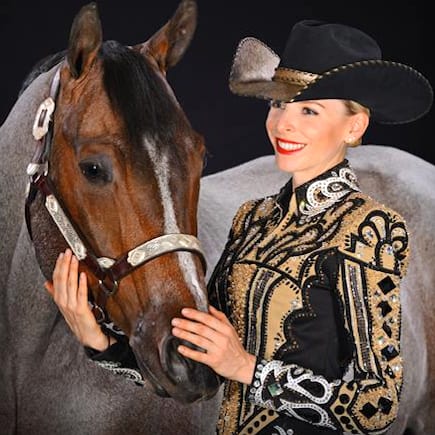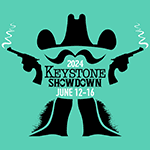Everyone knows horse showing is all about the clothes, right? Well, maybe not. But you cannot ignore the importance of a great outfit. Not only do you feel confident when you know you look good but a great outfit sends a winning message to the judges too. And while everyone defines a great outfit differently, there are some key elements that comprise every great outfit. I enlisted the help of top designers, Paula Diuri, Lindsay James, Anna Omodeo and Beckie Peskin as well as hat expert, Barbara Maitia to help me come up with my five elements that make up a successful outfit.
If you want judges to pay attention to you, the fit of your outfit is the most important element regarding your attire. A well tailored garment stands out in the crowd – in fact – often that
is the single most outstanding detail of a great look. A well tailored garment stands out in the crowd. Designers admit it is not realistic to expect a good fit without
tailoring, regardless of the item. Personally, I like a roomy fit in my hunt coats. It simply feels better to have the freedom to move my arms about without any restraint when bridling a 16’3 hand horse. However, when customers and friends asked if I had to borrow a hunt coat or had lost weight, it was a sign that I needed to alter my ways – and my clothes!
1) A Good Fit
Beckie Peskin, owner of On Pattern Designs and a top competitor herself, advises customers to pay attention to the piece that is most noticeable first. For Beckie, good fitting chaps are a must. She would rather have a customer spend less on the jacket or shirt and have chaps that fit well. “They need to come up high enough to cover their belt. I see a lot of too-low chaps out there. It just doesn’t present a nice line.” With jackets she finds the biggest problem is in shoulders that are not “set” well and leave bulges in the small of the back. Beckie also advises clients to try the entire outfit on and do a “trial run” – including sitting on the horse. “Things can change once you get in the saddle”, she says.
2) Good Fabric
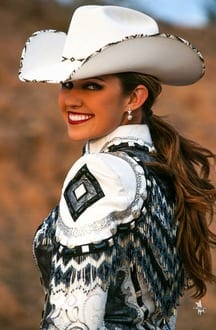 Again this is not so much about the cost of the fabric as it is about the quality of the fabric. Better fabrics are made from better yarns and properly sized before woven. Sizing is a protective process that improves efficiency of the weaving process. It also makes the fabric more resistant to hairiness, stronger, more elastic, smoother and heavier. Sizing is the reason good fabric holds its shape and color better than less expensive fabrics. The dry cleaning process takes a big a toll on your clothes – perhaps more so than sweating in a dusty arena for days on end. Make sure the fabric will withstand the wear and tear that a riding outfit will need to endure.
Again this is not so much about the cost of the fabric as it is about the quality of the fabric. Better fabrics are made from better yarns and properly sized before woven. Sizing is a protective process that improves efficiency of the weaving process. It also makes the fabric more resistant to hairiness, stronger, more elastic, smoother and heavier. Sizing is the reason good fabric holds its shape and color better than less expensive fabrics. The dry cleaning process takes a big a toll on your clothes – perhaps more so than sweating in a dusty arena for days on end. Make sure the fabric will withstand the wear and tear that a riding outfit will need to endure.
When choosing fabric for your outfit, designer Paula Diuri from Paula’s Place chooses fabrics that will withstand the wear and tear that show apparel undergoes. “Face it”, she says, “no fabric is made for the abuse it takes at a horse show.” To that end, she says better quality usually means better wear although she cautions that expensive silks will not wear well in show clothes.
Paula, who has been designing clothes for the industry’s top competitors for over 25 years, also places a great deal of importance on the glues and adhesives used in making a garment. For Paula, every piece of an outfit has to have a purpose. She tells her clients that sometimes less is more. “You want your eye to have a place to rest. Otherwise you will not see the entire design – it will look like a smattering of glitter, leather and color. Even with abstract designs, your eye has to find a quite spot. Everything has to have reason and flow.” For Paula, that means that the highest quality fabrics, notions and adhesives go into each piece. That is why she can guarantee her products.
3) Attention to Detail
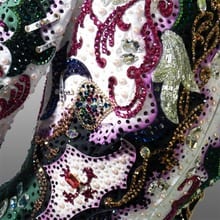 It is not so much that judges can see every little detail; I’m here to tell you that they cannot. It is much more the overall effect that attention to detail has on the entire outfit. “Everyone can use runway quality Italian leather and combine it with Swarovski crystals, but not everyone can make those details work in the bigger picture,” says Italian show clothes designer, Anna Omodeo of La Collezione di Anna of Italy. “Adding complexity, those details have to be well-designed to hide the horse and rider weaknesses (both physical and functional) and to enhance the strengths. This is particularly important in a horsemanship class, where harmony and balance have a main role,” Anna astutely states.
It is not so much that judges can see every little detail; I’m here to tell you that they cannot. It is much more the overall effect that attention to detail has on the entire outfit. “Everyone can use runway quality Italian leather and combine it with Swarovski crystals, but not everyone can make those details work in the bigger picture,” says Italian show clothes designer, Anna Omodeo of La Collezione di Anna of Italy. “Adding complexity, those details have to be well-designed to hide the horse and rider weaknesses (both physical and functional) and to enhance the strengths. This is particularly important in a horsemanship class, where harmony and balance have a main role,” Anna astutely states.
Anna avoids using a lot of colored crystals in the wrists if she feels the rider’s arm tends to move while riding. She also uses airbrush shadows and lines to make the rider’s figure look slim and balanced. Other details are just plain functional – as in expensive zippers and lining that won’t irritate the rider’s skin when worn for long hours in hot weather. Anna actually uses the same high tech material used by professional motorbike racers. Anna sums up her philosophy by reminding riders that a “top quality outfit will make the rider feel more confident, and in my experience a judge can really tell the difference between a rider that feels confident and one that doesn’t.”
4) Appropriateness
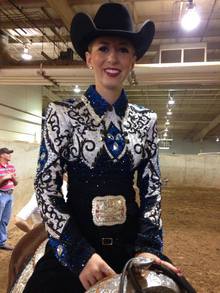 Make sure that the outfit you long for is appropriate for the event you intend to show in. You do not want your outfit to distract from the overall picture. Your outfit should enhance your body, compliment your horse’s color and not draw undue attention to the wrong areas. According to Lindsey James of Lindsey James Show Clothing, a well-fitted and tailored outfit is the most important element of show clothing. Lindsey specializes in helping riders find just the right outfit – one that shows off the rider’s style while enhancing the rider’s positive features.
Make sure that the outfit you long for is appropriate for the event you intend to show in. You do not want your outfit to distract from the overall picture. Your outfit should enhance your body, compliment your horse’s color and not draw undue attention to the wrong areas. According to Lindsey James of Lindsey James Show Clothing, a well-fitted and tailored outfit is the most important element of show clothing. Lindsey specializes in helping riders find just the right outfit – one that shows off the rider’s style while enhancing the rider’s positive features.
If you love fringe but Horsemanship is your main event, keep the fringe on your play jacket – not on your Horsemanship jacket. Designed to move, fringe exaggerates movement – a distraction to the clean lines desired in horsemanship. Lindsey suggests you keep the color of your jacket appropriate for your age. While you might love pink, it is too youthful to be seen head-to-toe in a showmanship outfit for a Select exhibitor. Some colors should just not graduate from the 11 and under division. Add vivid colors or wild details in tasteful designs or appropriate subtleties like the piping or pinstripe in your hunt coat. That is what professionals do – design outfits to show off your style while keeping your panache grounded in appropriateness.
5) A Great Hat
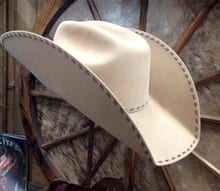 A great hat is the hallmark of a great outfit. Hats that are properly shaped, crisp and clean set riders apart. This does not mean the fanciest, the most outlandish or a super-sparkly hat. I mean pure and simple, a great shaped hat! Obviously we are not all the same size or shape and our heads are not either. It is unrealistic to think that we can all wear the same shaped hat. For example “if you have a small narrow face you would wear your hat along the lines from the middle of your chin to the outside of your eyebrows” says Barbara of Barbara’s Custom Hats. “The same is still true for a rounder face but the angles are much wider. You need to look proportionate and your hat should not only compliment your outfit but complete it’s look. Take into consideration the size and width of your shoulders and chest. A bigger and taller person can support a bigger brim and the hat looks like it was custom to their body shape and style and not just perched on the top of their head. For a smaller person or child you want to stay away from the huge crowns that swallow your face and cover your eyes especially in showmanship,” says Barbara.
A great hat is the hallmark of a great outfit. Hats that are properly shaped, crisp and clean set riders apart. This does not mean the fanciest, the most outlandish or a super-sparkly hat. I mean pure and simple, a great shaped hat! Obviously we are not all the same size or shape and our heads are not either. It is unrealistic to think that we can all wear the same shaped hat. For example “if you have a small narrow face you would wear your hat along the lines from the middle of your chin to the outside of your eyebrows” says Barbara of Barbara’s Custom Hats. “The same is still true for a rounder face but the angles are much wider. You need to look proportionate and your hat should not only compliment your outfit but complete it’s look. Take into consideration the size and width of your shoulders and chest. A bigger and taller person can support a bigger brim and the hat looks like it was custom to their body shape and style and not just perched on the top of their head. For a smaller person or child you want to stay away from the huge crowns that swallow your face and cover your eyes especially in showmanship,” says Barbara.
 Again, you do not have to have the most expensive hat. However, keep in mind with your hat as with everything else, you get what you pay for. There is no industry standard so a higher percentage of beaver does not guarantee a better hat. Inexpensive hats typically do not hold their shape especially in the coming hot and humid months.
Again, you do not have to have the most expensive hat. However, keep in mind with your hat as with everything else, you get what you pay for. There is no industry standard so a higher percentage of beaver does not guarantee a better hat. Inexpensive hats typically do not hold their shape especially in the coming hot and humid months.
And let’s not forget the hunt seat rider. While hunt hats seem to have no fashion or season, the new ASTM/SEI approved helmets do come in a variety of shapes, exterior texture and colors. They too have design improvements that make one fit or another a better option depending on your needs.
As with all of your attire, it is best to purchase one good quality item than three average items. Always think quality over quantity when it comes to your outfit. It is understandable for exhibitors to tire of an outfit, but keep in mind today’s judge has no idea what you wore yesterday or last week. Judges can tell when someone has grown, shrunk, borrowed or gone the extra step to ensure a good fit. They can distinguish between rumpled and pressed, worn out or properly worn. Judges love to see a great fitting tailored outfit that looks clean, pressed and professional yet remains functional. Designers are in the business of making you look good – they want you to feel confident, to be comfortable and to have a winning look. Invest in quality and you will look, feel and act like a winner.
About Stephanie Lynn: Professional Horseman Stephanie Lynn coached her first AQHA World Champion in 1988. She has since coached, trained and shown World, Congress and Honor Roll horses across disciplines. She is a judge for AQHA, NSBA and APHA and has judged World Championship shows for each association. Most recently, Stephanie is the author of The Good Rider Series and A Lifetime Affair: Lessons Learned Living My Passion. The Good Rider Series is a library of resource material that is both practical and applicable in the barn and show ring for riders. Stephanie can always be reached through her website: http://www.stephanielynn.net to answer your questions, schedule a clinic or lesson.
Photos © Shane Rux, Emajes Design


